Adidas Singapore Pte Ltd: Transportation and Distribution Case Study
VerifiedAdded on 2020/04/21
|12
|3106
|1679
Case Study
AI Summary
This case study analyzes the transportation and distribution management of Adidas Singapore Pte Ltd. The study examines the organization's use of air, sea, and road transportation, with a focus on cost-effectiveness and environmental sustainability. It delves into incoterms selection, recommending Free Alongside Ship (FAS) as a suitable option, and outlines carrier selection criteria, emphasizing geographic coverage, transit time, and reliability. Furthermore, the case study explores carrier relationship management goals, highlighting the importance of responsiveness, innovation, and technology adoption. The analysis provides insights into Adidas's strategies for optimizing its supply chain and managing carrier relationships to achieve economic growth and competitiveness in the global market.
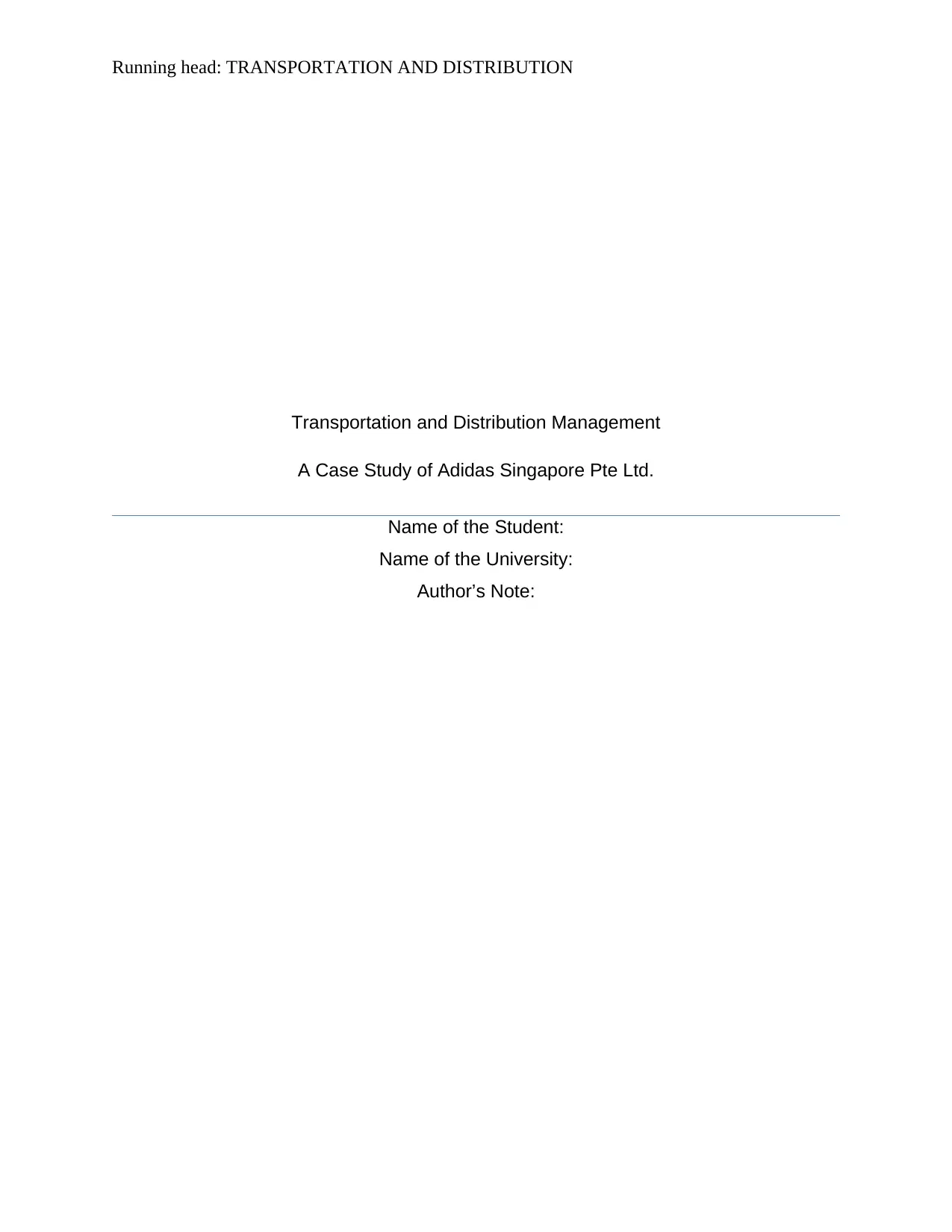
Running head: TRANSPORTATION AND DISTRIBUTION
Transportation and Distribution Management
A Case Study of Adidas Singapore Pte Ltd.
Name of the Student:
Name of the University:
Author’s Note:
Transportation and Distribution Management
A Case Study of Adidas Singapore Pte Ltd.
Name of the Student:
Name of the University:
Author’s Note:
Paraphrase This Document
Need a fresh take? Get an instant paraphrase of this document with our AI Paraphraser
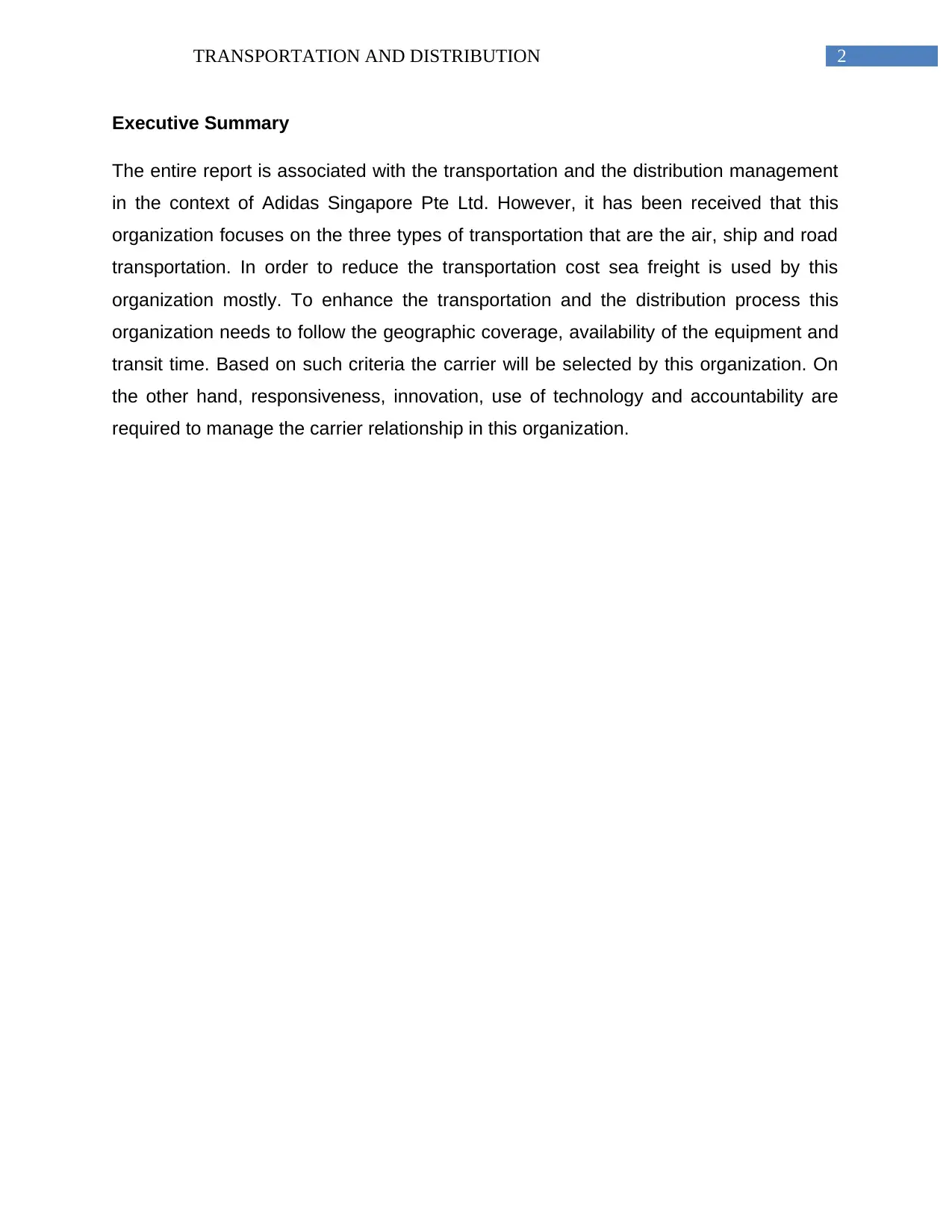
2TRANSPORTATION AND DISTRIBUTION
Executive Summary
The entire report is associated with the transportation and the distribution management
in the context of Adidas Singapore Pte Ltd. However, it has been received that this
organization focuses on the three types of transportation that are the air, ship and road
transportation. In order to reduce the transportation cost sea freight is used by this
organization mostly. To enhance the transportation and the distribution process this
organization needs to follow the geographic coverage, availability of the equipment and
transit time. Based on such criteria the carrier will be selected by this organization. On
the other hand, responsiveness, innovation, use of technology and accountability are
required to manage the carrier relationship in this organization.
Executive Summary
The entire report is associated with the transportation and the distribution management
in the context of Adidas Singapore Pte Ltd. However, it has been received that this
organization focuses on the three types of transportation that are the air, ship and road
transportation. In order to reduce the transportation cost sea freight is used by this
organization mostly. To enhance the transportation and the distribution process this
organization needs to follow the geographic coverage, availability of the equipment and
transit time. Based on such criteria the carrier will be selected by this organization. On
the other hand, responsiveness, innovation, use of technology and accountability are
required to manage the carrier relationship in this organization.
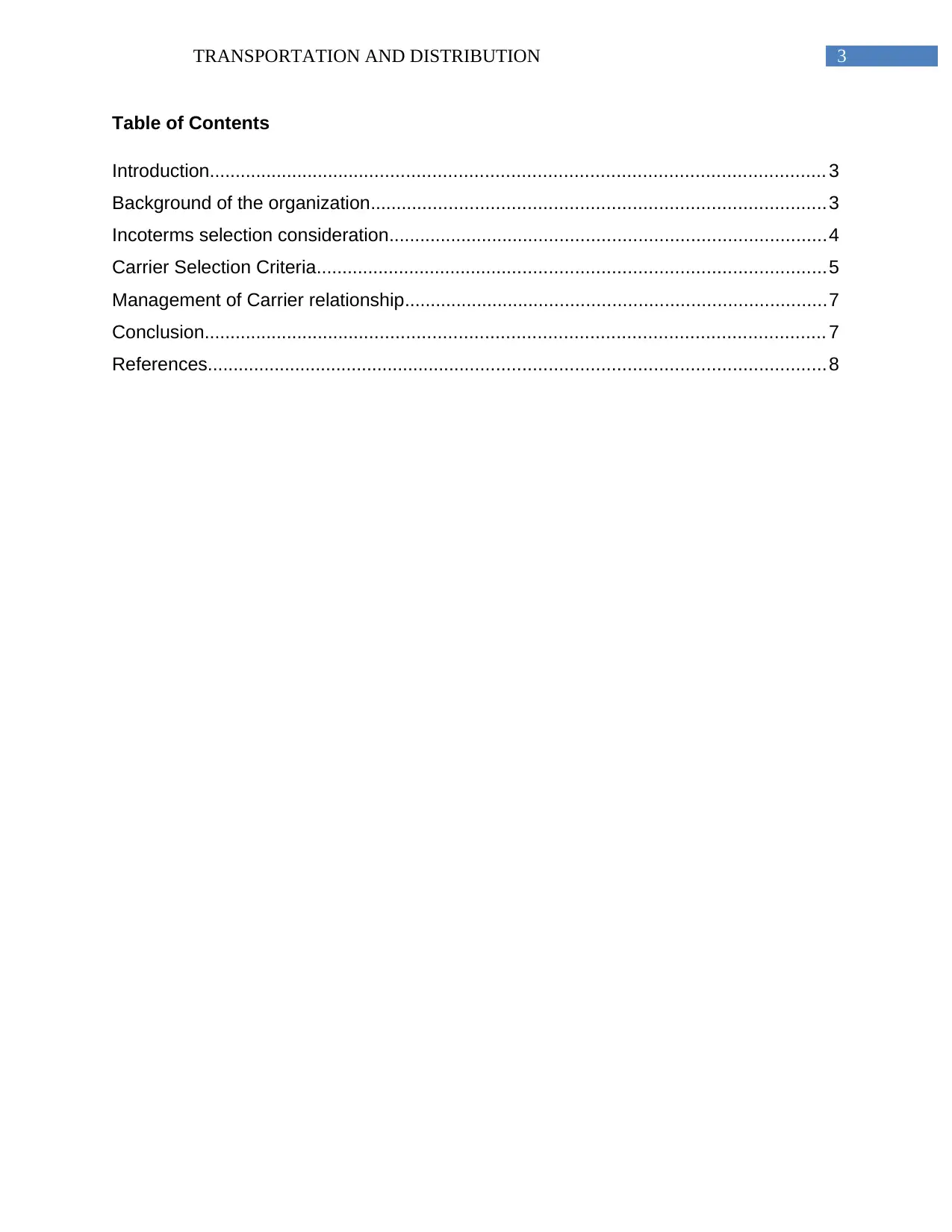
3TRANSPORTATION AND DISTRIBUTION
Table of Contents
Introduction...................................................................................................................... 3
Background of the organization.......................................................................................3
Incoterms selection consideration....................................................................................4
Carrier Selection Criteria..................................................................................................5
Management of Carrier relationship.................................................................................7
Conclusion....................................................................................................................... 7
References.......................................................................................................................8
Table of Contents
Introduction...................................................................................................................... 3
Background of the organization.......................................................................................3
Incoterms selection consideration....................................................................................4
Carrier Selection Criteria..................................................................................................5
Management of Carrier relationship.................................................................................7
Conclusion....................................................................................................................... 7
References.......................................................................................................................8
⊘ This is a preview!⊘
Do you want full access?
Subscribe today to unlock all pages.

Trusted by 1+ million students worldwide
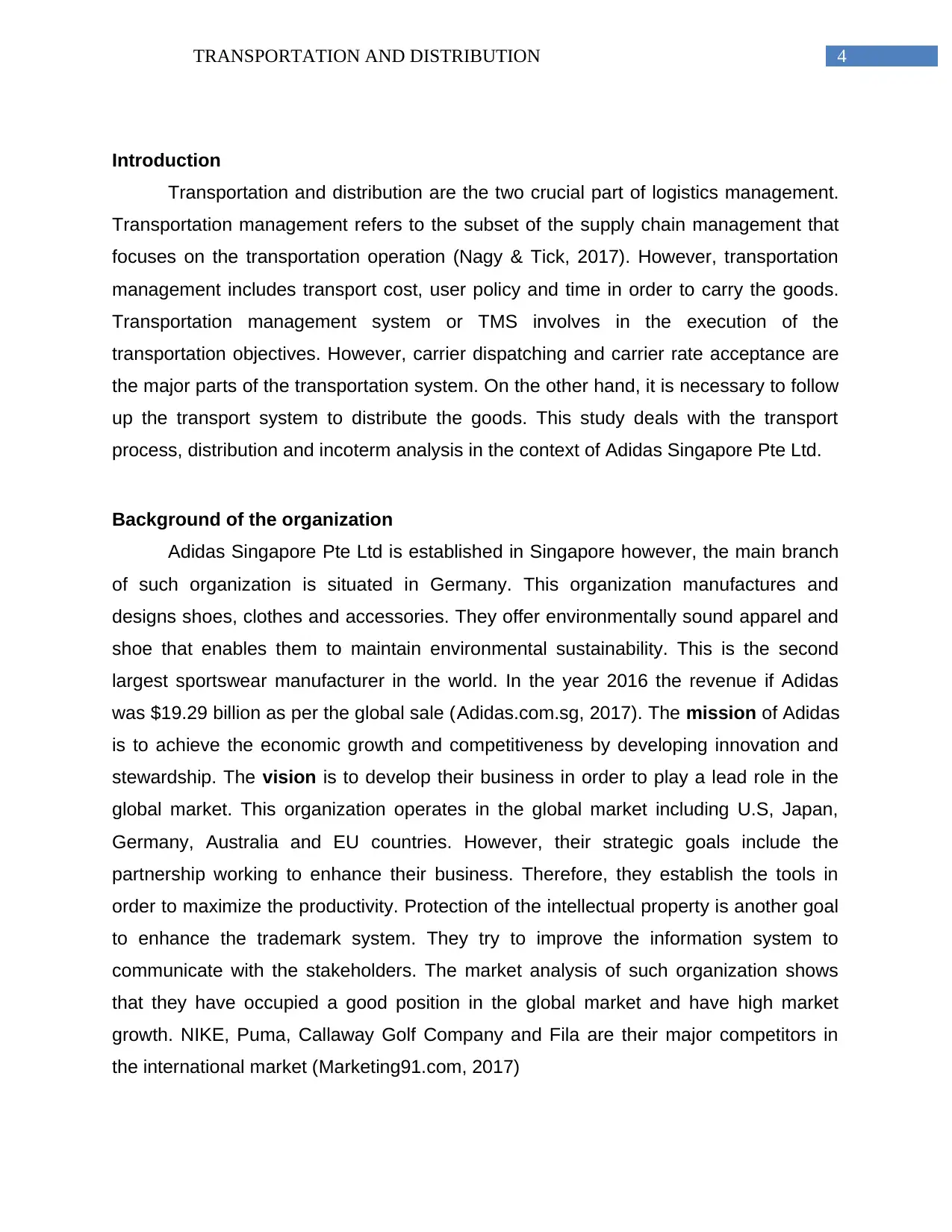
4TRANSPORTATION AND DISTRIBUTION
Introduction
Transportation and distribution are the two crucial part of logistics management.
Transportation management refers to the subset of the supply chain management that
focuses on the transportation operation (Nagy & Tick, 2017). However, transportation
management includes transport cost, user policy and time in order to carry the goods.
Transportation management system or TMS involves in the execution of the
transportation objectives. However, carrier dispatching and carrier rate acceptance are
the major parts of the transportation system. On the other hand, it is necessary to follow
up the transport system to distribute the goods. This study deals with the transport
process, distribution and incoterm analysis in the context of Adidas Singapore Pte Ltd.
Background of the organization
Adidas Singapore Pte Ltd is established in Singapore however, the main branch
of such organization is situated in Germany. This organization manufactures and
designs shoes, clothes and accessories. They offer environmentally sound apparel and
shoe that enables them to maintain environmental sustainability. This is the second
largest sportswear manufacturer in the world. In the year 2016 the revenue if Adidas
was $19.29 billion as per the global sale (Adidas.com.sg, 2017). The mission of Adidas
is to achieve the economic growth and competitiveness by developing innovation and
stewardship. The vision is to develop their business in order to play a lead role in the
global market. This organization operates in the global market including U.S, Japan,
Germany, Australia and EU countries. However, their strategic goals include the
partnership working to enhance their business. Therefore, they establish the tools in
order to maximize the productivity. Protection of the intellectual property is another goal
to enhance the trademark system. They try to improve the information system to
communicate with the stakeholders. The market analysis of such organization shows
that they have occupied a good position in the global market and have high market
growth. NIKE, Puma, Callaway Golf Company and Fila are their major competitors in
the international market (Marketing91.com, 2017)
Introduction
Transportation and distribution are the two crucial part of logistics management.
Transportation management refers to the subset of the supply chain management that
focuses on the transportation operation (Nagy & Tick, 2017). However, transportation
management includes transport cost, user policy and time in order to carry the goods.
Transportation management system or TMS involves in the execution of the
transportation objectives. However, carrier dispatching and carrier rate acceptance are
the major parts of the transportation system. On the other hand, it is necessary to follow
up the transport system to distribute the goods. This study deals with the transport
process, distribution and incoterm analysis in the context of Adidas Singapore Pte Ltd.
Background of the organization
Adidas Singapore Pte Ltd is established in Singapore however, the main branch
of such organization is situated in Germany. This organization manufactures and
designs shoes, clothes and accessories. They offer environmentally sound apparel and
shoe that enables them to maintain environmental sustainability. This is the second
largest sportswear manufacturer in the world. In the year 2016 the revenue if Adidas
was $19.29 billion as per the global sale (Adidas.com.sg, 2017). The mission of Adidas
is to achieve the economic growth and competitiveness by developing innovation and
stewardship. The vision is to develop their business in order to play a lead role in the
global market. This organization operates in the global market including U.S, Japan,
Germany, Australia and EU countries. However, their strategic goals include the
partnership working to enhance their business. Therefore, they establish the tools in
order to maximize the productivity. Protection of the intellectual property is another goal
to enhance the trademark system. They try to improve the information system to
communicate with the stakeholders. The market analysis of such organization shows
that they have occupied a good position in the global market and have high market
growth. NIKE, Puma, Callaway Golf Company and Fila are their major competitors in
the international market (Marketing91.com, 2017)
Paraphrase This Document
Need a fresh take? Get an instant paraphrase of this document with our AI Paraphraser
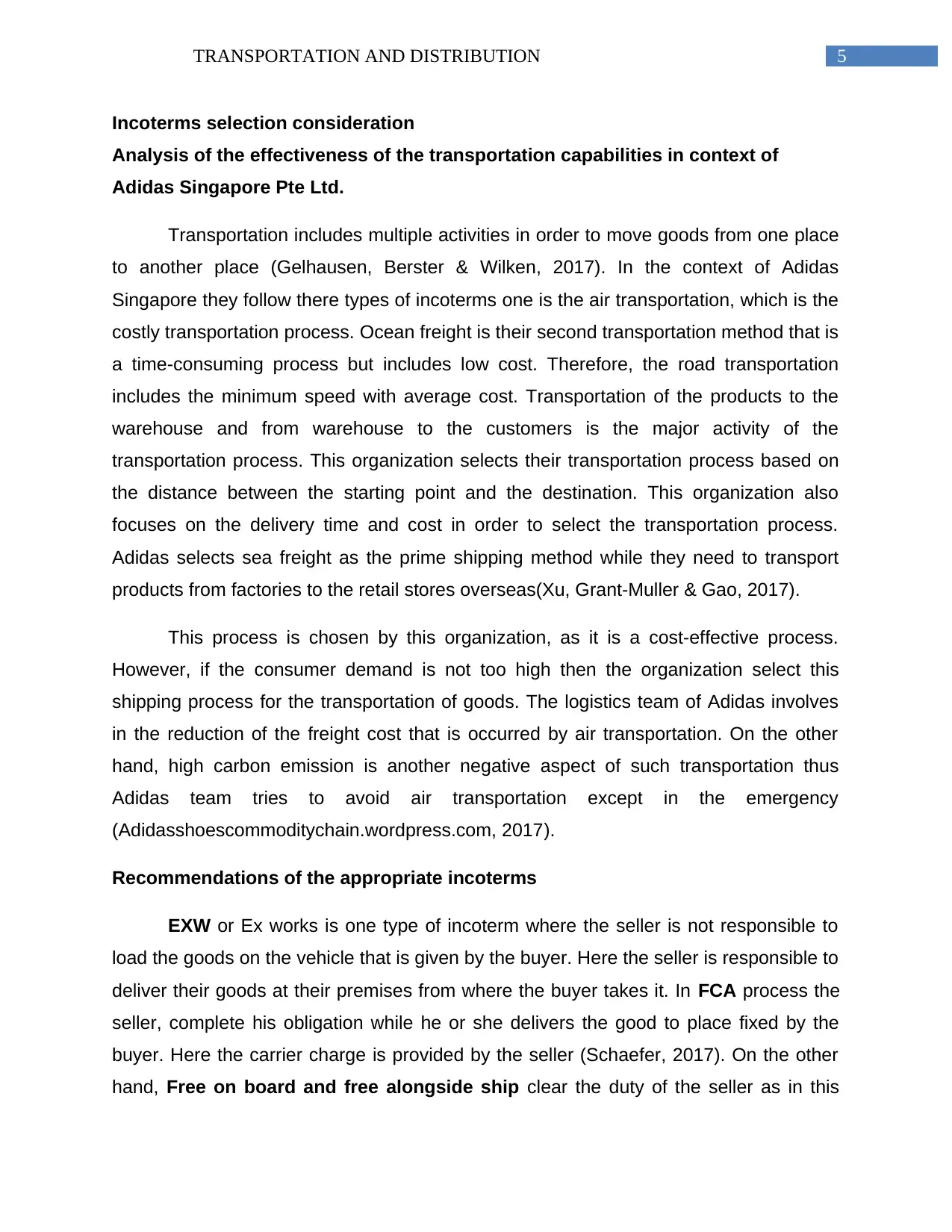
5TRANSPORTATION AND DISTRIBUTION
Incoterms selection consideration
Analysis of the effectiveness of the transportation capabilities in context of
Adidas Singapore Pte Ltd.
Transportation includes multiple activities in order to move goods from one place
to another place (Gelhausen, Berster & Wilken, 2017). In the context of Adidas
Singapore they follow there types of incoterms one is the air transportation, which is the
costly transportation process. Ocean freight is their second transportation method that is
a time-consuming process but includes low cost. Therefore, the road transportation
includes the minimum speed with average cost. Transportation of the products to the
warehouse and from warehouse to the customers is the major activity of the
transportation process. This organization selects their transportation process based on
the distance between the starting point and the destination. This organization also
focuses on the delivery time and cost in order to select the transportation process.
Adidas selects sea freight as the prime shipping method while they need to transport
products from factories to the retail stores overseas(Xu, Grant-Muller & Gao, 2017).
This process is chosen by this organization, as it is a cost-effective process.
However, if the consumer demand is not too high then the organization select this
shipping process for the transportation of goods. The logistics team of Adidas involves
in the reduction of the freight cost that is occurred by air transportation. On the other
hand, high carbon emission is another negative aspect of such transportation thus
Adidas team tries to avoid air transportation except in the emergency
(Adidasshoescommoditychain.wordpress.com, 2017).
Recommendations of the appropriate incoterms
EXW or Ex works is one type of incoterm where the seller is not responsible to
load the goods on the vehicle that is given by the buyer. Here the seller is responsible to
deliver their goods at their premises from where the buyer takes it. In FCA process the
seller, complete his obligation while he or she delivers the good to place fixed by the
buyer. Here the carrier charge is provided by the seller (Schaefer, 2017). On the other
hand, Free on board and free alongside ship clear the duty of the seller as in this
Incoterms selection consideration
Analysis of the effectiveness of the transportation capabilities in context of
Adidas Singapore Pte Ltd.
Transportation includes multiple activities in order to move goods from one place
to another place (Gelhausen, Berster & Wilken, 2017). In the context of Adidas
Singapore they follow there types of incoterms one is the air transportation, which is the
costly transportation process. Ocean freight is their second transportation method that is
a time-consuming process but includes low cost. Therefore, the road transportation
includes the minimum speed with average cost. Transportation of the products to the
warehouse and from warehouse to the customers is the major activity of the
transportation process. This organization selects their transportation process based on
the distance between the starting point and the destination. This organization also
focuses on the delivery time and cost in order to select the transportation process.
Adidas selects sea freight as the prime shipping method while they need to transport
products from factories to the retail stores overseas(Xu, Grant-Muller & Gao, 2017).
This process is chosen by this organization, as it is a cost-effective process.
However, if the consumer demand is not too high then the organization select this
shipping process for the transportation of goods. The logistics team of Adidas involves
in the reduction of the freight cost that is occurred by air transportation. On the other
hand, high carbon emission is another negative aspect of such transportation thus
Adidas team tries to avoid air transportation except in the emergency
(Adidasshoescommoditychain.wordpress.com, 2017).
Recommendations of the appropriate incoterms
EXW or Ex works is one type of incoterm where the seller is not responsible to
load the goods on the vehicle that is given by the buyer. Here the seller is responsible to
deliver their goods at their premises from where the buyer takes it. In FCA process the
seller, complete his obligation while he or she delivers the good to place fixed by the
buyer. Here the carrier charge is provided by the seller (Schaefer, 2017). On the other
hand, Free on board and free alongside ship clear the duty of the seller as in this
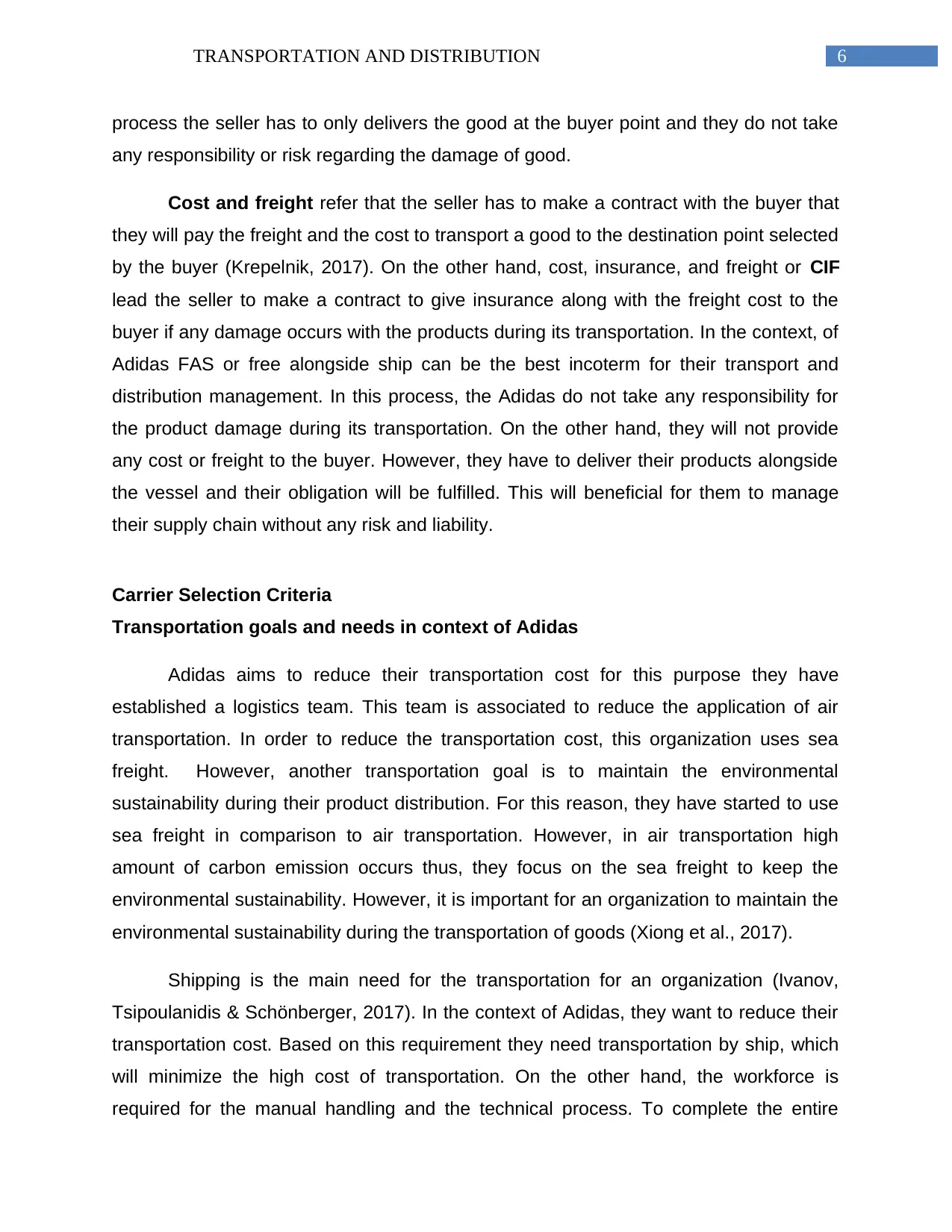
6TRANSPORTATION AND DISTRIBUTION
process the seller has to only delivers the good at the buyer point and they do not take
any responsibility or risk regarding the damage of good.
Cost and freight refer that the seller has to make a contract with the buyer that
they will pay the freight and the cost to transport a good to the destination point selected
by the buyer (Krepelnik, 2017). On the other hand, cost, insurance, and freight or CIF
lead the seller to make a contract to give insurance along with the freight cost to the
buyer if any damage occurs with the products during its transportation. In the context, of
Adidas FAS or free alongside ship can be the best incoterm for their transport and
distribution management. In this process, the Adidas do not take any responsibility for
the product damage during its transportation. On the other hand, they will not provide
any cost or freight to the buyer. However, they have to deliver their products alongside
the vessel and their obligation will be fulfilled. This will beneficial for them to manage
their supply chain without any risk and liability.
Carrier Selection Criteria
Transportation goals and needs in context of Adidas
Adidas aims to reduce their transportation cost for this purpose they have
established a logistics team. This team is associated to reduce the application of air
transportation. In order to reduce the transportation cost, this organization uses sea
freight. However, another transportation goal is to maintain the environmental
sustainability during their product distribution. For this reason, they have started to use
sea freight in comparison to air transportation. However, in air transportation high
amount of carbon emission occurs thus, they focus on the sea freight to keep the
environmental sustainability. However, it is important for an organization to maintain the
environmental sustainability during the transportation of goods (Xiong et al., 2017).
Shipping is the main need for the transportation for an organization (Ivanov,
Tsipoulanidis & Schönberger, 2017). In the context of Adidas, they want to reduce their
transportation cost. Based on this requirement they need transportation by ship, which
will minimize the high cost of transportation. On the other hand, the workforce is
required for the manual handling and the technical process. To complete the entire
process the seller has to only delivers the good at the buyer point and they do not take
any responsibility or risk regarding the damage of good.
Cost and freight refer that the seller has to make a contract with the buyer that
they will pay the freight and the cost to transport a good to the destination point selected
by the buyer (Krepelnik, 2017). On the other hand, cost, insurance, and freight or CIF
lead the seller to make a contract to give insurance along with the freight cost to the
buyer if any damage occurs with the products during its transportation. In the context, of
Adidas FAS or free alongside ship can be the best incoterm for their transport and
distribution management. In this process, the Adidas do not take any responsibility for
the product damage during its transportation. On the other hand, they will not provide
any cost or freight to the buyer. However, they have to deliver their products alongside
the vessel and their obligation will be fulfilled. This will beneficial for them to manage
their supply chain without any risk and liability.
Carrier Selection Criteria
Transportation goals and needs in context of Adidas
Adidas aims to reduce their transportation cost for this purpose they have
established a logistics team. This team is associated to reduce the application of air
transportation. In order to reduce the transportation cost, this organization uses sea
freight. However, another transportation goal is to maintain the environmental
sustainability during their product distribution. For this reason, they have started to use
sea freight in comparison to air transportation. However, in air transportation high
amount of carbon emission occurs thus, they focus on the sea freight to keep the
environmental sustainability. However, it is important for an organization to maintain the
environmental sustainability during the transportation of goods (Xiong et al., 2017).
Shipping is the main need for the transportation for an organization (Ivanov,
Tsipoulanidis & Schönberger, 2017). In the context of Adidas, they want to reduce their
transportation cost. Based on this requirement they need transportation by ship, which
will minimize the high cost of transportation. On the other hand, the workforce is
required for the manual handling and the technical process. To complete the entire
⊘ This is a preview!⊘
Do you want full access?
Subscribe today to unlock all pages.

Trusted by 1+ million students worldwide
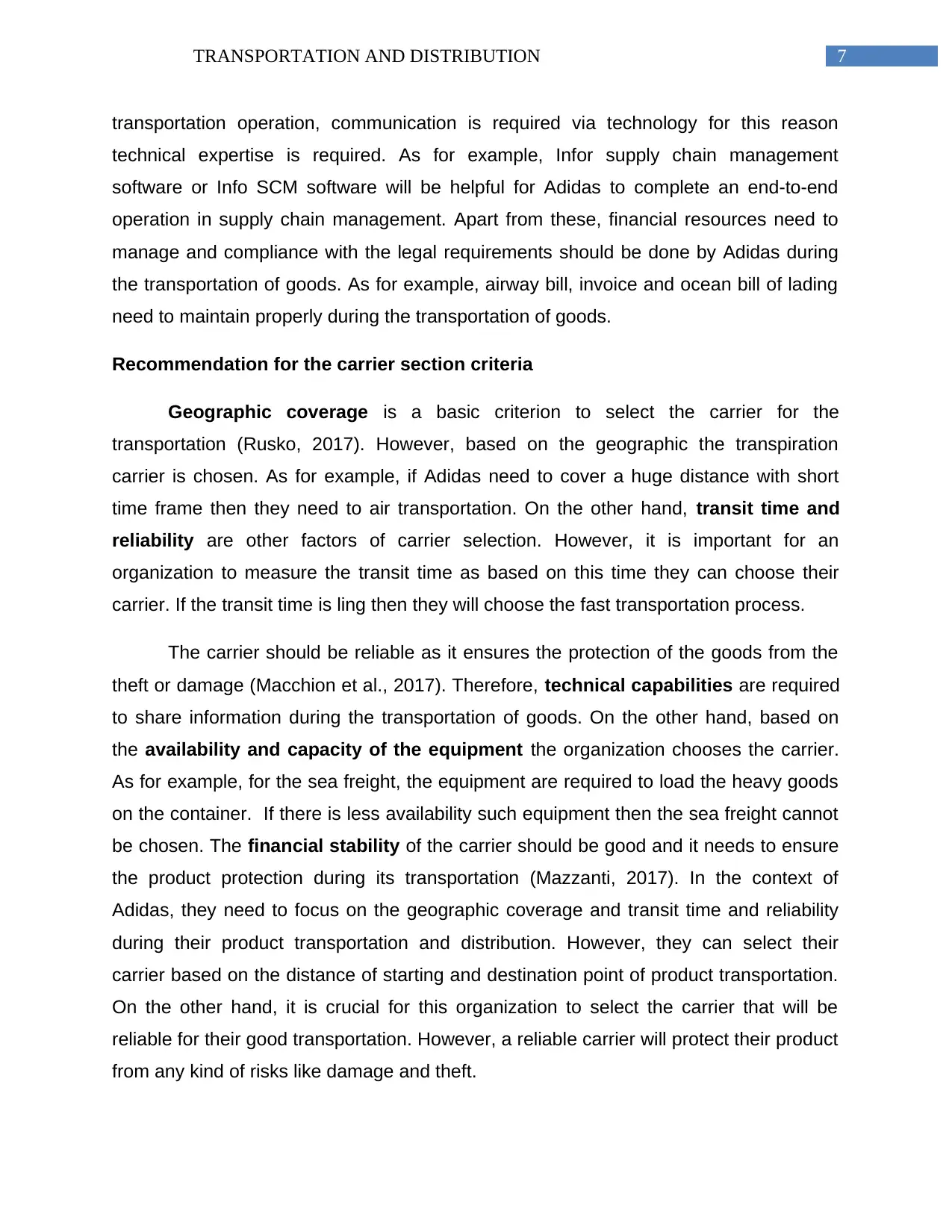
7TRANSPORTATION AND DISTRIBUTION
transportation operation, communication is required via technology for this reason
technical expertise is required. As for example, Infor supply chain management
software or Info SCM software will be helpful for Adidas to complete an end-to-end
operation in supply chain management. Apart from these, financial resources need to
manage and compliance with the legal requirements should be done by Adidas during
the transportation of goods. As for example, airway bill, invoice and ocean bill of lading
need to maintain properly during the transportation of goods.
Recommendation for the carrier section criteria
Geographic coverage is a basic criterion to select the carrier for the
transportation (Rusko, 2017). However, based on the geographic the transpiration
carrier is chosen. As for example, if Adidas need to cover a huge distance with short
time frame then they need to air transportation. On the other hand, transit time and
reliability are other factors of carrier selection. However, it is important for an
organization to measure the transit time as based on this time they can choose their
carrier. If the transit time is ling then they will choose the fast transportation process.
The carrier should be reliable as it ensures the protection of the goods from the
theft or damage (Macchion et al., 2017). Therefore, technical capabilities are required
to share information during the transportation of goods. On the other hand, based on
the availability and capacity of the equipment the organization chooses the carrier.
As for example, for the sea freight, the equipment are required to load the heavy goods
on the container. If there is less availability such equipment then the sea freight cannot
be chosen. The financial stability of the carrier should be good and it needs to ensure
the product protection during its transportation (Mazzanti, 2017). In the context of
Adidas, they need to focus on the geographic coverage and transit time and reliability
during their product transportation and distribution. However, they can select their
carrier based on the distance of starting and destination point of product transportation.
On the other hand, it is crucial for this organization to select the carrier that will be
reliable for their good transportation. However, a reliable carrier will protect their product
from any kind of risks like damage and theft.
transportation operation, communication is required via technology for this reason
technical expertise is required. As for example, Infor supply chain management
software or Info SCM software will be helpful for Adidas to complete an end-to-end
operation in supply chain management. Apart from these, financial resources need to
manage and compliance with the legal requirements should be done by Adidas during
the transportation of goods. As for example, airway bill, invoice and ocean bill of lading
need to maintain properly during the transportation of goods.
Recommendation for the carrier section criteria
Geographic coverage is a basic criterion to select the carrier for the
transportation (Rusko, 2017). However, based on the geographic the transpiration
carrier is chosen. As for example, if Adidas need to cover a huge distance with short
time frame then they need to air transportation. On the other hand, transit time and
reliability are other factors of carrier selection. However, it is important for an
organization to measure the transit time as based on this time they can choose their
carrier. If the transit time is ling then they will choose the fast transportation process.
The carrier should be reliable as it ensures the protection of the goods from the
theft or damage (Macchion et al., 2017). Therefore, technical capabilities are required
to share information during the transportation of goods. On the other hand, based on
the availability and capacity of the equipment the organization chooses the carrier.
As for example, for the sea freight, the equipment are required to load the heavy goods
on the container. If there is less availability such equipment then the sea freight cannot
be chosen. The financial stability of the carrier should be good and it needs to ensure
the product protection during its transportation (Mazzanti, 2017). In the context of
Adidas, they need to focus on the geographic coverage and transit time and reliability
during their product transportation and distribution. However, they can select their
carrier based on the distance of starting and destination point of product transportation.
On the other hand, it is crucial for this organization to select the carrier that will be
reliable for their good transportation. However, a reliable carrier will protect their product
from any kind of risks like damage and theft.
Paraphrase This Document
Need a fresh take? Get an instant paraphrase of this document with our AI Paraphraser
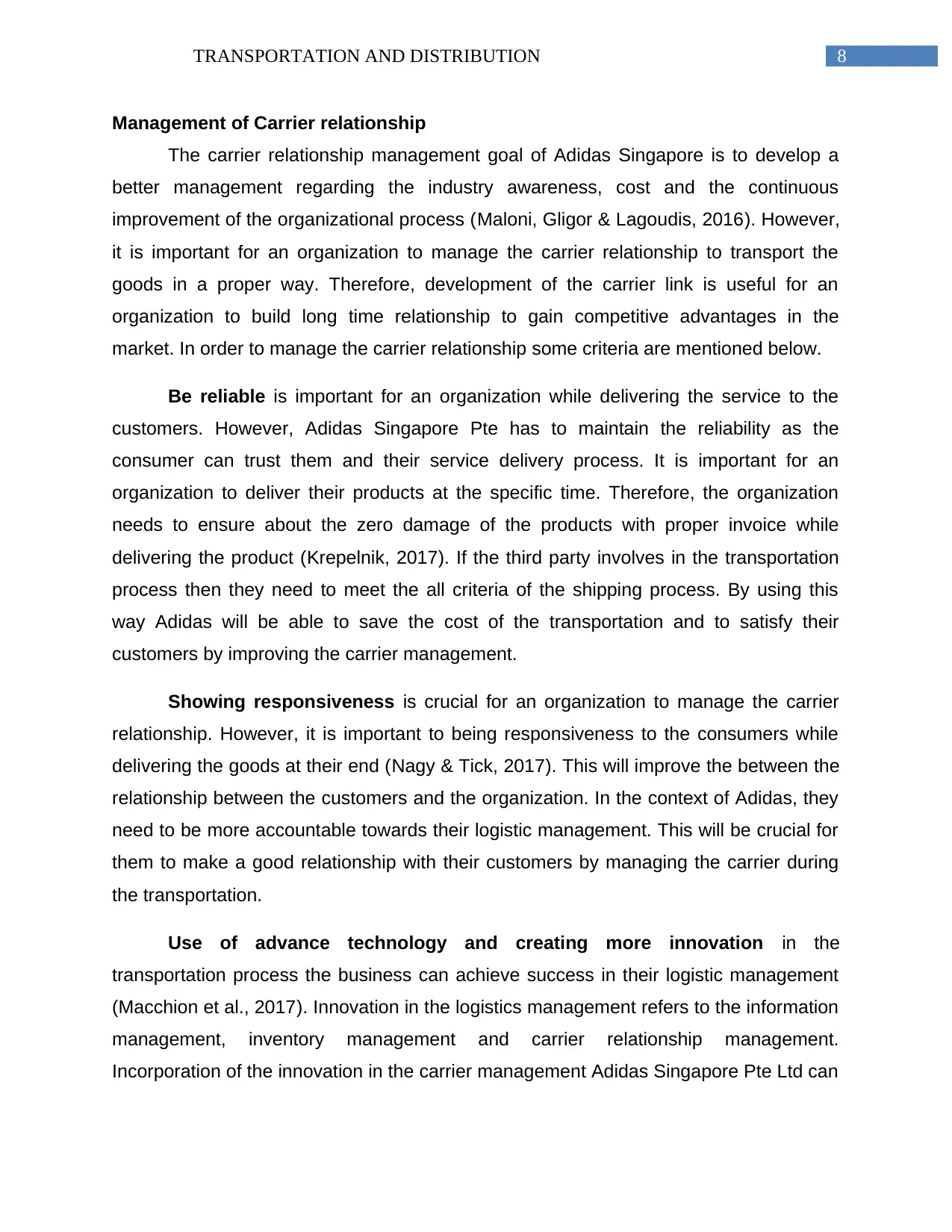
8TRANSPORTATION AND DISTRIBUTION
Management of Carrier relationship
The carrier relationship management goal of Adidas Singapore is to develop a
better management regarding the industry awareness, cost and the continuous
improvement of the organizational process (Maloni, Gligor & Lagoudis, 2016). However,
it is important for an organization to manage the carrier relationship to transport the
goods in a proper way. Therefore, development of the carrier link is useful for an
organization to build long time relationship to gain competitive advantages in the
market. In order to manage the carrier relationship some criteria are mentioned below.
Be reliable is important for an organization while delivering the service to the
customers. However, Adidas Singapore Pte has to maintain the reliability as the
consumer can trust them and their service delivery process. It is important for an
organization to deliver their products at the specific time. Therefore, the organization
needs to ensure about the zero damage of the products with proper invoice while
delivering the product (Krepelnik, 2017). If the third party involves in the transportation
process then they need to meet the all criteria of the shipping process. By using this
way Adidas will be able to save the cost of the transportation and to satisfy their
customers by improving the carrier management.
Showing responsiveness is crucial for an organization to manage the carrier
relationship. However, it is important to being responsiveness to the consumers while
delivering the goods at their end (Nagy & Tick, 2017). This will improve the between the
relationship between the customers and the organization. In the context of Adidas, they
need to be more accountable towards their logistic management. This will be crucial for
them to make a good relationship with their customers by managing the carrier during
the transportation.
Use of advance technology and creating more innovation in the
transportation process the business can achieve success in their logistic management
(Macchion et al., 2017). Innovation in the logistics management refers to the information
management, inventory management and carrier relationship management.
Incorporation of the innovation in the carrier management Adidas Singapore Pte Ltd can
Management of Carrier relationship
The carrier relationship management goal of Adidas Singapore is to develop a
better management regarding the industry awareness, cost and the continuous
improvement of the organizational process (Maloni, Gligor & Lagoudis, 2016). However,
it is important for an organization to manage the carrier relationship to transport the
goods in a proper way. Therefore, development of the carrier link is useful for an
organization to build long time relationship to gain competitive advantages in the
market. In order to manage the carrier relationship some criteria are mentioned below.
Be reliable is important for an organization while delivering the service to the
customers. However, Adidas Singapore Pte has to maintain the reliability as the
consumer can trust them and their service delivery process. It is important for an
organization to deliver their products at the specific time. Therefore, the organization
needs to ensure about the zero damage of the products with proper invoice while
delivering the product (Krepelnik, 2017). If the third party involves in the transportation
process then they need to meet the all criteria of the shipping process. By using this
way Adidas will be able to save the cost of the transportation and to satisfy their
customers by improving the carrier management.
Showing responsiveness is crucial for an organization to manage the carrier
relationship. However, it is important to being responsiveness to the consumers while
delivering the goods at their end (Nagy & Tick, 2017). This will improve the between the
relationship between the customers and the organization. In the context of Adidas, they
need to be more accountable towards their logistic management. This will be crucial for
them to make a good relationship with their customers by managing the carrier during
the transportation.
Use of advance technology and creating more innovation in the
transportation process the business can achieve success in their logistic management
(Macchion et al., 2017). Innovation in the logistics management refers to the information
management, inventory management and carrier relationship management.
Incorporation of the innovation in the carrier management Adidas Singapore Pte Ltd can
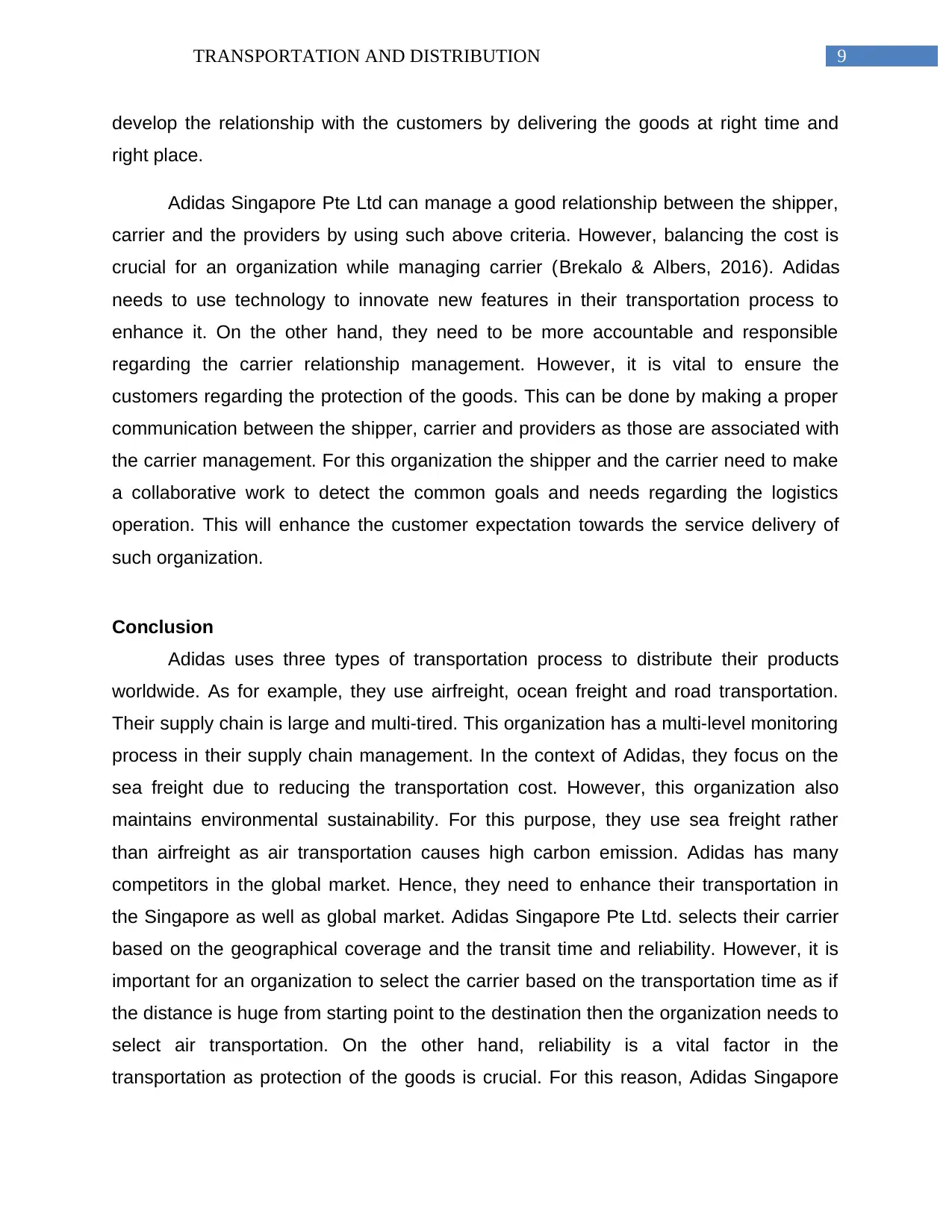
9TRANSPORTATION AND DISTRIBUTION
develop the relationship with the customers by delivering the goods at right time and
right place.
Adidas Singapore Pte Ltd can manage a good relationship between the shipper,
carrier and the providers by using such above criteria. However, balancing the cost is
crucial for an organization while managing carrier (Brekalo & Albers, 2016). Adidas
needs to use technology to innovate new features in their transportation process to
enhance it. On the other hand, they need to be more accountable and responsible
regarding the carrier relationship management. However, it is vital to ensure the
customers regarding the protection of the goods. This can be done by making a proper
communication between the shipper, carrier and providers as those are associated with
the carrier management. For this organization the shipper and the carrier need to make
a collaborative work to detect the common goals and needs regarding the logistics
operation. This will enhance the customer expectation towards the service delivery of
such organization.
Conclusion
Adidas uses three types of transportation process to distribute their products
worldwide. As for example, they use airfreight, ocean freight and road transportation.
Their supply chain is large and multi-tired. This organization has a multi-level monitoring
process in their supply chain management. In the context of Adidas, they focus on the
sea freight due to reducing the transportation cost. However, this organization also
maintains environmental sustainability. For this purpose, they use sea freight rather
than airfreight as air transportation causes high carbon emission. Adidas has many
competitors in the global market. Hence, they need to enhance their transportation in
the Singapore as well as global market. Adidas Singapore Pte Ltd. selects their carrier
based on the geographical coverage and the transit time and reliability. However, it is
important for an organization to select the carrier based on the transportation time as if
the distance is huge from starting point to the destination then the organization needs to
select air transportation. On the other hand, reliability is a vital factor in the
transportation as protection of the goods is crucial. For this reason, Adidas Singapore
develop the relationship with the customers by delivering the goods at right time and
right place.
Adidas Singapore Pte Ltd can manage a good relationship between the shipper,
carrier and the providers by using such above criteria. However, balancing the cost is
crucial for an organization while managing carrier (Brekalo & Albers, 2016). Adidas
needs to use technology to innovate new features in their transportation process to
enhance it. On the other hand, they need to be more accountable and responsible
regarding the carrier relationship management. However, it is vital to ensure the
customers regarding the protection of the goods. This can be done by making a proper
communication between the shipper, carrier and providers as those are associated with
the carrier management. For this organization the shipper and the carrier need to make
a collaborative work to detect the common goals and needs regarding the logistics
operation. This will enhance the customer expectation towards the service delivery of
such organization.
Conclusion
Adidas uses three types of transportation process to distribute their products
worldwide. As for example, they use airfreight, ocean freight and road transportation.
Their supply chain is large and multi-tired. This organization has a multi-level monitoring
process in their supply chain management. In the context of Adidas, they focus on the
sea freight due to reducing the transportation cost. However, this organization also
maintains environmental sustainability. For this purpose, they use sea freight rather
than airfreight as air transportation causes high carbon emission. Adidas has many
competitors in the global market. Hence, they need to enhance their transportation in
the Singapore as well as global market. Adidas Singapore Pte Ltd. selects their carrier
based on the geographical coverage and the transit time and reliability. However, it is
important for an organization to select the carrier based on the transportation time as if
the distance is huge from starting point to the destination then the organization needs to
select air transportation. On the other hand, reliability is a vital factor in the
transportation as protection of the goods is crucial. For this reason, Adidas Singapore
⊘ This is a preview!⊘
Do you want full access?
Subscribe today to unlock all pages.

Trusted by 1+ million students worldwide
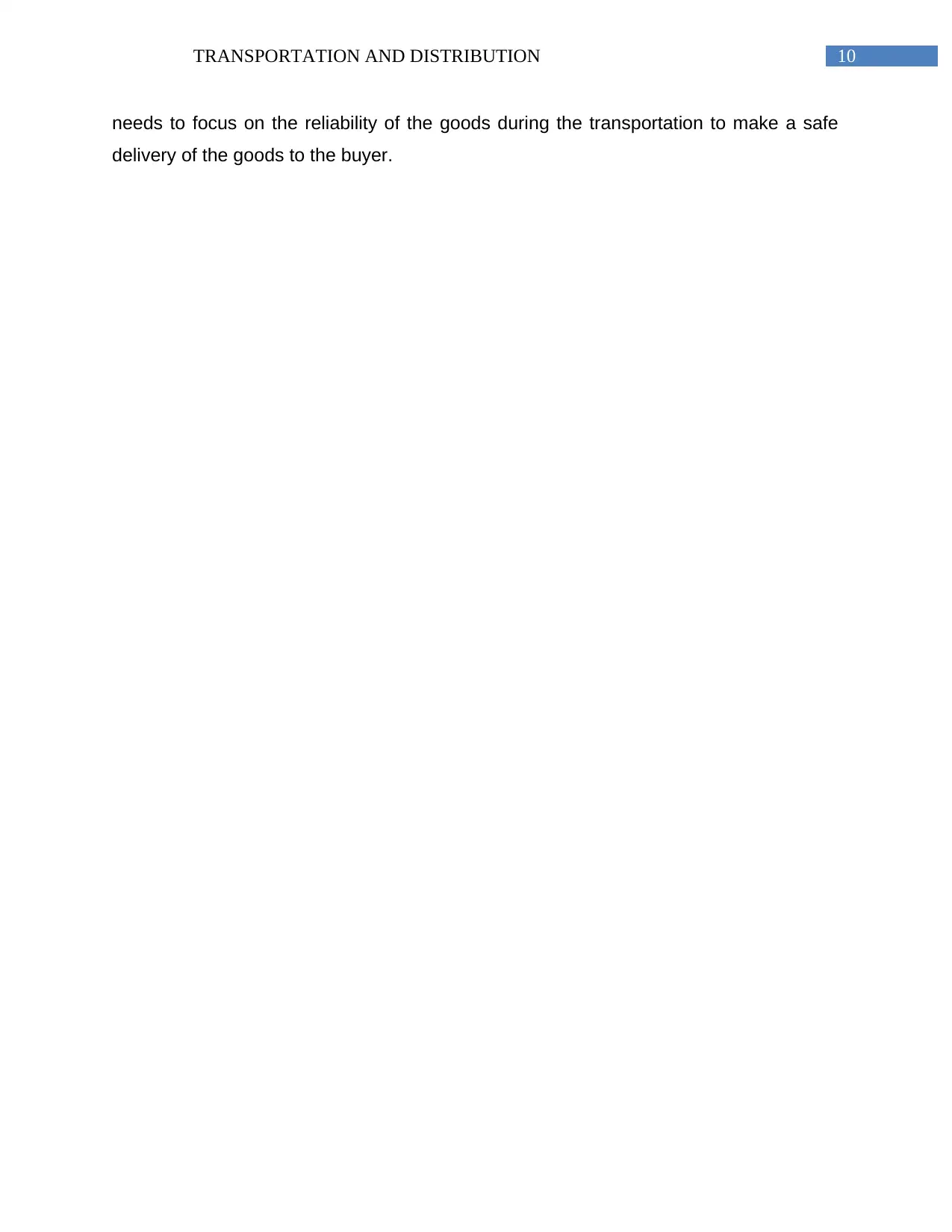
10TRANSPORTATION AND DISTRIBUTION
needs to focus on the reliability of the goods during the transportation to make a safe
delivery of the goods to the buyer.
needs to focus on the reliability of the goods during the transportation to make a safe
delivery of the goods to the buyer.
Paraphrase This Document
Need a fresh take? Get an instant paraphrase of this document with our AI Paraphraser
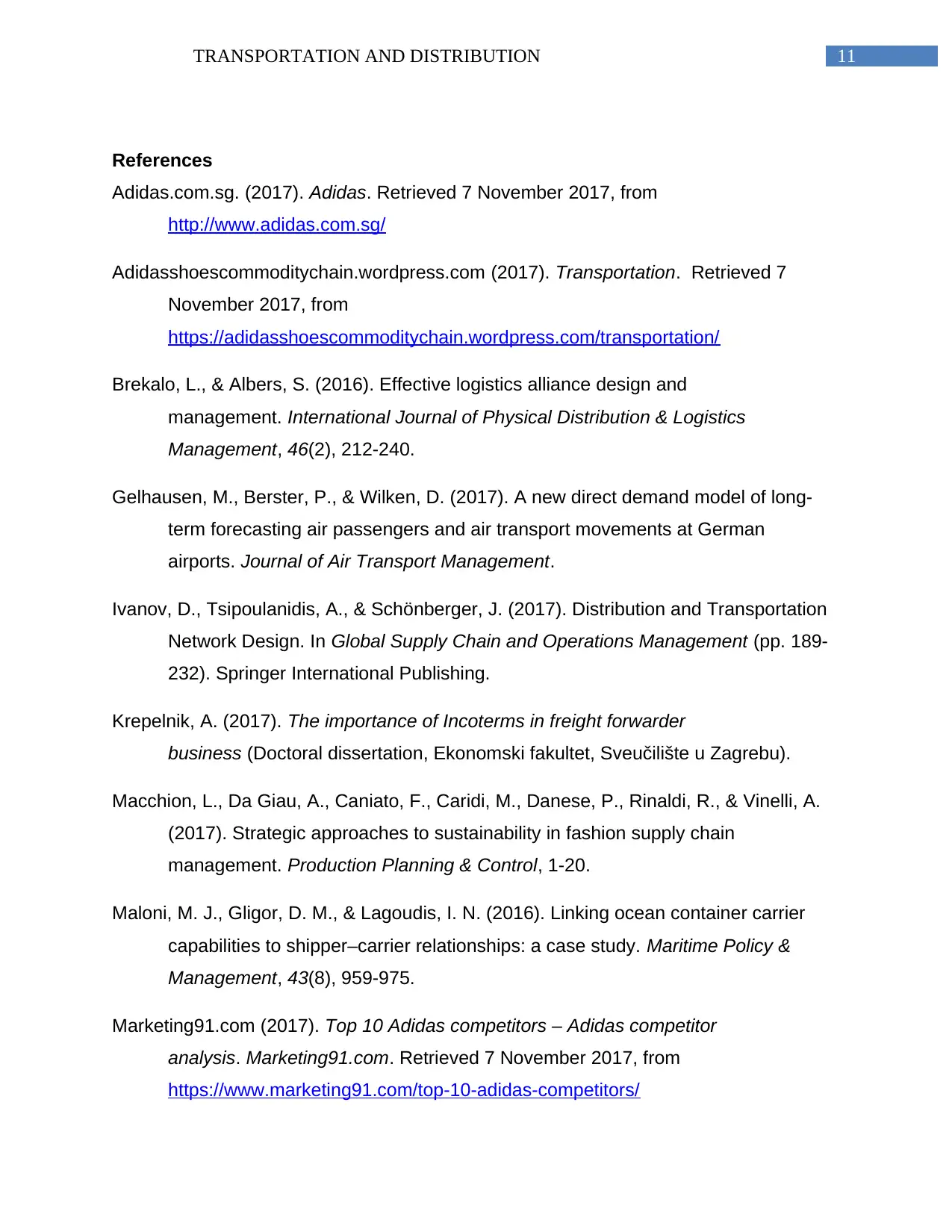
11TRANSPORTATION AND DISTRIBUTION
References
Adidas.com.sg. (2017). Adidas. Retrieved 7 November 2017, from
http://www.adidas.com.sg/
Adidasshoescommoditychain.wordpress.com (2017). Transportation. Retrieved 7
November 2017, from
https://adidasshoescommoditychain.wordpress.com/transportation/
Brekalo, L., & Albers, S. (2016). Effective logistics alliance design and
management. International Journal of Physical Distribution & Logistics
Management, 46(2), 212-240.
Gelhausen, M., Berster, P., & Wilken, D. (2017). A new direct demand model of long-
term forecasting air passengers and air transport movements at German
airports. Journal of Air Transport Management.
Ivanov, D., Tsipoulanidis, A., & Schönberger, J. (2017). Distribution and Transportation
Network Design. In Global Supply Chain and Operations Management (pp. 189-
232). Springer International Publishing.
Krepelnik, A. (2017). The importance of Incoterms in freight forwarder
business (Doctoral dissertation, Ekonomski fakultet, Sveučilište u Zagrebu).
Macchion, L., Da Giau, A., Caniato, F., Caridi, M., Danese, P., Rinaldi, R., & Vinelli, A.
(2017). Strategic approaches to sustainability in fashion supply chain
management. Production Planning & Control, 1-20.
Maloni, M. J., Gligor, D. M., & Lagoudis, I. N. (2016). Linking ocean container carrier
capabilities to shipper–carrier relationships: a case study. Maritime Policy &
Management, 43(8), 959-975.
Marketing91.com (2017). Top 10 Adidas competitors – Adidas competitor
analysis. Marketing91.com. Retrieved 7 November 2017, from
https://www.marketing91.com/top-10-adidas-competitors/
References
Adidas.com.sg. (2017). Adidas. Retrieved 7 November 2017, from
http://www.adidas.com.sg/
Adidasshoescommoditychain.wordpress.com (2017). Transportation. Retrieved 7
November 2017, from
https://adidasshoescommoditychain.wordpress.com/transportation/
Brekalo, L., & Albers, S. (2016). Effective logistics alliance design and
management. International Journal of Physical Distribution & Logistics
Management, 46(2), 212-240.
Gelhausen, M., Berster, P., & Wilken, D. (2017). A new direct demand model of long-
term forecasting air passengers and air transport movements at German
airports. Journal of Air Transport Management.
Ivanov, D., Tsipoulanidis, A., & Schönberger, J. (2017). Distribution and Transportation
Network Design. In Global Supply Chain and Operations Management (pp. 189-
232). Springer International Publishing.
Krepelnik, A. (2017). The importance of Incoterms in freight forwarder
business (Doctoral dissertation, Ekonomski fakultet, Sveučilište u Zagrebu).
Macchion, L., Da Giau, A., Caniato, F., Caridi, M., Danese, P., Rinaldi, R., & Vinelli, A.
(2017). Strategic approaches to sustainability in fashion supply chain
management. Production Planning & Control, 1-20.
Maloni, M. J., Gligor, D. M., & Lagoudis, I. N. (2016). Linking ocean container carrier
capabilities to shipper–carrier relationships: a case study. Maritime Policy &
Management, 43(8), 959-975.
Marketing91.com (2017). Top 10 Adidas competitors – Adidas competitor
analysis. Marketing91.com. Retrieved 7 November 2017, from
https://www.marketing91.com/top-10-adidas-competitors/
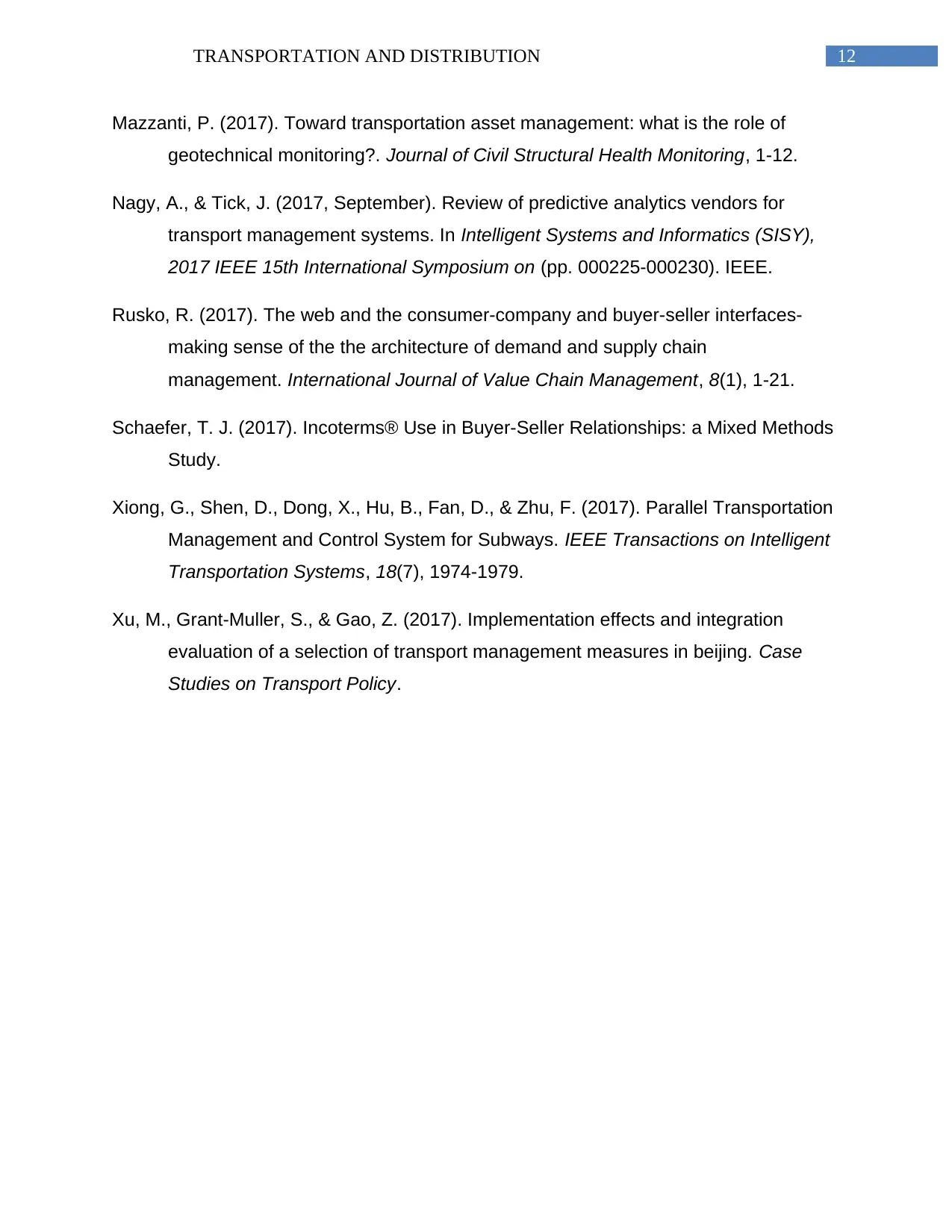
12TRANSPORTATION AND DISTRIBUTION
Mazzanti, P. (2017). Toward transportation asset management: what is the role of
geotechnical monitoring?. Journal of Civil Structural Health Monitoring, 1-12.
Nagy, A., & Tick, J. (2017, September). Review of predictive analytics vendors for
transport management systems. In Intelligent Systems and Informatics (SISY),
2017 IEEE 15th International Symposium on (pp. 000225-000230). IEEE.
Rusko, R. (2017). The web and the consumer-company and buyer-seller interfaces-
making sense of the the architecture of demand and supply chain
management. International Journal of Value Chain Management, 8(1), 1-21.
Schaefer, T. J. (2017). Incoterms® Use in Buyer-Seller Relationships: a Mixed Methods
Study.
Xiong, G., Shen, D., Dong, X., Hu, B., Fan, D., & Zhu, F. (2017). Parallel Transportation
Management and Control System for Subways. IEEE Transactions on Intelligent
Transportation Systems, 18(7), 1974-1979.
Xu, M., Grant-Muller, S., & Gao, Z. (2017). Implementation effects and integration
evaluation of a selection of transport management measures in beijing. Case
Studies on Transport Policy.
Mazzanti, P. (2017). Toward transportation asset management: what is the role of
geotechnical monitoring?. Journal of Civil Structural Health Monitoring, 1-12.
Nagy, A., & Tick, J. (2017, September). Review of predictive analytics vendors for
transport management systems. In Intelligent Systems and Informatics (SISY),
2017 IEEE 15th International Symposium on (pp. 000225-000230). IEEE.
Rusko, R. (2017). The web and the consumer-company and buyer-seller interfaces-
making sense of the the architecture of demand and supply chain
management. International Journal of Value Chain Management, 8(1), 1-21.
Schaefer, T. J. (2017). Incoterms® Use in Buyer-Seller Relationships: a Mixed Methods
Study.
Xiong, G., Shen, D., Dong, X., Hu, B., Fan, D., & Zhu, F. (2017). Parallel Transportation
Management and Control System for Subways. IEEE Transactions on Intelligent
Transportation Systems, 18(7), 1974-1979.
Xu, M., Grant-Muller, S., & Gao, Z. (2017). Implementation effects and integration
evaluation of a selection of transport management measures in beijing. Case
Studies on Transport Policy.
⊘ This is a preview!⊘
Do you want full access?
Subscribe today to unlock all pages.

Trusted by 1+ million students worldwide
1 out of 12
Related Documents
Your All-in-One AI-Powered Toolkit for Academic Success.
+13062052269
info@desklib.com
Available 24*7 on WhatsApp / Email
![[object Object]](/_next/static/media/star-bottom.7253800d.svg)
Unlock your academic potential
Copyright © 2020–2025 A2Z Services. All Rights Reserved. Developed and managed by ZUCOL.





